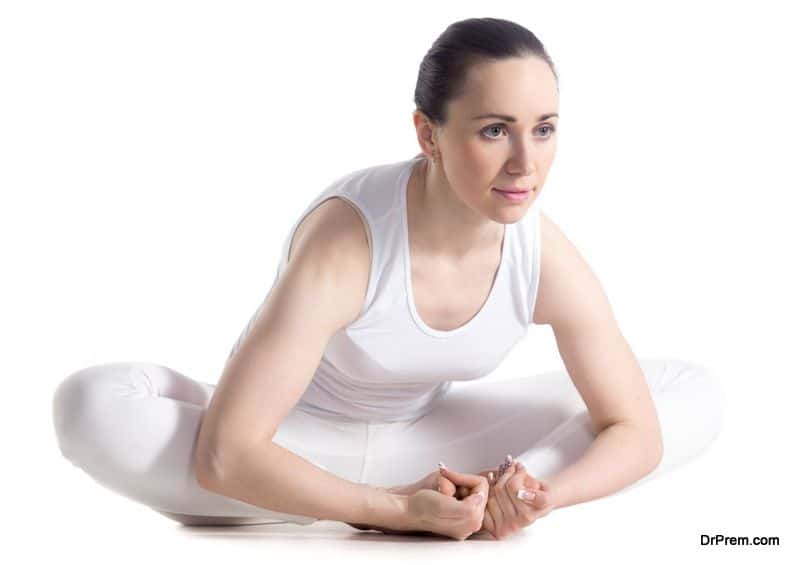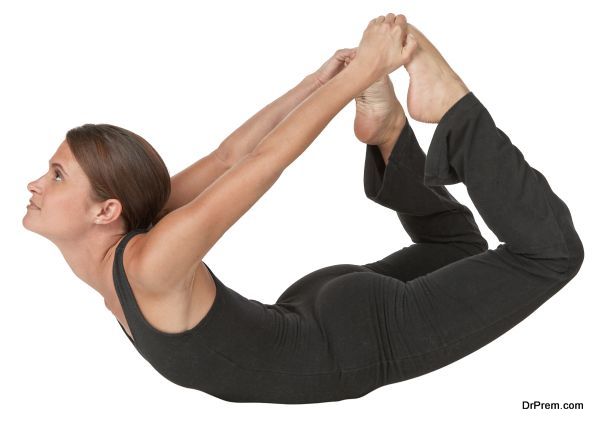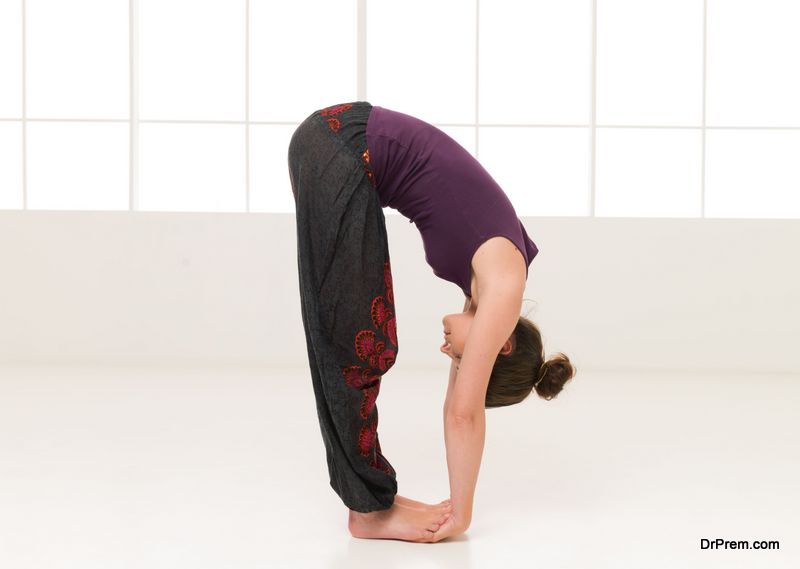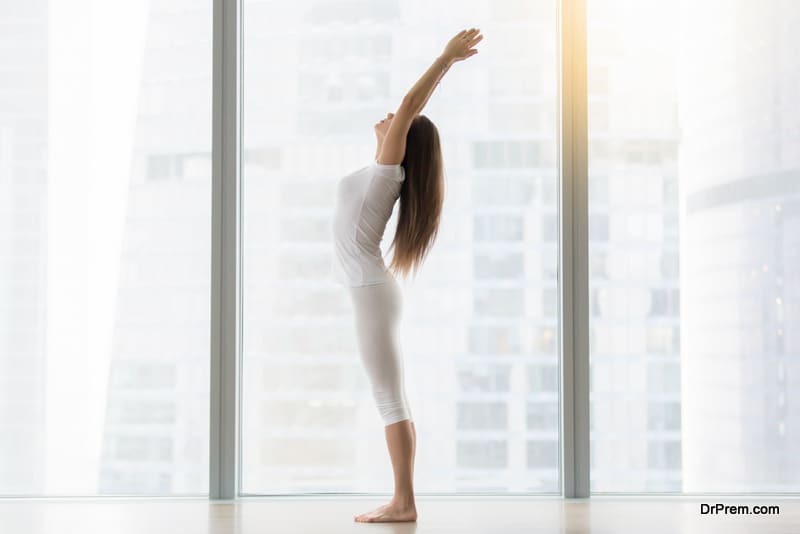Most of the health disorders including gynecological problems that plague the life of women stem from unhealthy lifestyle. Stress, lack of proper physical exercises and bad eating habits have made women vulnerable to gynecological problems. The best way of naturally countering gynecological problems is practicing yoga asanas everyday. There are several yoga asanas, which can help in preventing, controlling and curing gynecological disorders in women. In the following, some of the best yogic cures have been discussed for your benefit.
Guide to yoga poses that help in gynecological problems and pregnancy
-
For keeping irregular menstrual cycles at bay
-
For Obligomenorrhea or infrequent periods
-
For curing PCOS
-
For smooth pregnancy
-
The best yoga during pregnancy
-
Titali asana
-
Utthanasan
-
Marjari asana
-
Pigeon pose
-
Virabhadrasana
-
Baddha konasana
-
Safety tips to consider
-
Perform yoga in water
-
Include props
-
Do not force yourself
-
Prioritize comfort
-
Encourage proper respiration
-
Drink sufficient water
-
Decrease holding time
-
Stick to breathing exercises
-
Never overlook pain
-
Refrain from exercising
-
Menopause problems and Yoga Asanas to cure it
-
Menopause, the Symptoms
-
Kapalabhati
-
Hands to Feet or Pada Hastasana
-
Mountain Pose or Tadasana
-
Sun salutation or Surya Namaskar
-
Warrior Pose
-
Tree Pose or Tadasana
-
Essential yoga poses for women
-
Child position
-
Downward Facing Dog
-
Warrior II
-
Plank Pose
-
Fierce Pose
For keeping irregular menstrual cycles at bay
Every woman experiences some sort of menstrual irregularities but when this problem increases, it may indicate a serious issue with the hypothalamus-pituitary-ovarian axis. Some of the inverted yoga positions are good for women suffering from irregularities in their menstrual cycle. The inverted asanas make blood flow to the brain and improves the metabolism within neuron cells.
The stimulation provided by these asanas can help in enhancing the connection between different parts of the hypothalamus-pituitary-ovarian axis. Inverted asanas like Parshva Sarvangasana and Parshva Halasaana are considered the best for curbing pelvic pains and other gynecological problems of the ovary and uterus.
For Obligomenorrhea or infrequent periods
Obligomenorrhea is a very common problem faced by women. The main reason why they suffer from this problem is sedentary lifestyle and excessive stress. Regular practice of forward bending yoga positions can help in improving the condition. Yoga positions like Trikonasana and Chakrasana can provide the right amount of pressure on the intra-abdominal region, which will cure pelvic and abdominal dysfunctions.
Breathing techniques are also considered a variety of yoga. It teaches one to regulate the movement of the abdomen and diaphragm, which helps in curing infrequent periods. Practice the Kumbhak technique of breathing regularly for best results. Breathing techniques can also make women feel less stressed and relieve their mind from tensions.
Some women also complain of bleeding between two periods. This can happen due to the weakness of pelvic muscles. Practice Pranayam throughout the month and practice Bhadrasana when your menses end for reducing this problem. Consumption of sufficient amount of folic acid and iron will also help women in recovering.
For curing PCOS
The main reason why women suffer from hormonal imbalances is that they are emotionally dependent on others for support and strength. Personal problems affect their self-image, esteem and confidence. Emotional stress pressurizes the brain and it fails to function properly. Meditation and relaxing yoga techniques like Anitya Bhavana and Nishapanda Bhav are good for reducing stress and problems stemming from it. Some yoga poses that also helps women suffering from PCOS are Bhadrasana, Bhujangasana, Shalbhasana, Konasana, Chakrasana, Sukhasana and Pranayam.
For smooth pregnancy
Pregnancy causes hormonal, physical and emotional changes in a woman. Many women find it difficult to conceive due to one gynecological problem or other. Even after conceiving, a woman must be cautious about maintaining the health of the child. Yoga poses can help in preventing the mother’s physical problems like diabetes, hypertension, stress and anxiety from affecting the child.
Doing light yoga throughout the different stages of pregnancy can keep both the mother and the child safe and healthy. Some suitable yoga poses for the first trimester of pregnancy are Poorna Titli Asana, Kati Chakrasana, and Cat Stretch Pose. In the second trimester practice Matsya Kridasana which helps in sleeping well and relaxing.
The best yoga during pregnancy
Prenatal yoga is the best way to encourage healthy minds, simple exercises which aid in accommodating a growing baby. This class of yoga helps in preparing the woman for the laborious task which she has to deal with. It also reduces blood pressure and thus benefits the nervous system at large. Prenatal yoga should always be performed after proper recommendations from experts in order to avoid injuries along the way. Given below is a list of few effective yoga poses for pregnant women.
Titali asana
Why is it recommended?
Also known as the butterfly pose, this asana is highly recommended as it is one of the most beneficial prenatal asanas. The asana removes all the tension which builds up in the inner thigh area and increases flexibility. This yoga pose eases childbirth to a great extent.
The pose
The yoga begins with you sitting on a mat with your legs stretched out in front of you. Now holding on to your ankles, both your legs are pulled closer inwards as much as possible. Ideally your heels should touch your pelvis area. After that slowly your legs are pushed outwards using your elbows, if necessary. You should be still holding on to your ankles to your palms. After sufficient practice your knees should be able to touch the mat.
Utthanasan
Why is it recommended?
The asana provides excellent blood circulation in your body and improves your central nervous system. It also aids in achieving great flexibility.
The pose
The starting position involves keeping your feet around three feet apart along with both the heels facing inwards and toes facing outwards. After this, interlock all fingers and let your hands hang down in front of you. Slowly squat downwards, keeping your buttocks low. Your feet should be flat on the floor and heels should not be raised. Retain this position for a few seconds and then stand up. The entire process needs to be repeated about 15 to 20 times.
Marjari asana
Why is it recommended?
Also known as the cat stretch pose, this asana is one of the most popular and highly recommended asanas. Apart from providing excellent flexibility in the back, it also makes the body sturdy, preparing it for delivery. It strengthens your neck, shoulders and spine and is excellent for your posture.
The pose
The asana begins with you sitting with your buttocks on your heels. Gradually your buttocks are raised off your heels and you bend forward, leaning on your palms. After you are on all fours, you need to move your feet slightly to the sides such that they are a foot or shoulder width apart. Now inhale and raise your head slowly, pushing down the arc of your back. Inhale again, rolling your head between your arms and pushing your back up. During exhaling, pull in your stomach, pulling your navel up towards your spine. Make sure you pull in your buttocks as well. This completes one round. Six such rounds need to be done effectively for good results.
Pigeon pose
Why is it recommended?
This asana is excellent for stretching the muscles of knee and the lower back. The gluts maximums, piriformis, orbtutator internus are the primary muscles which are exercised in this pose. This provides great strength and support to the entire body.
The pose
It can be performed well on a mat. Bring one knee forward to an end of the mat. The foot of the bent leg needs to be bent forward in order to stretch the knee. The other leg is stretched back, and your hands are placed at both sides. This position can be held for 30 seconds and can be repeated six times.
Virabhadrasana
Why is it recommended?
This asana has numerous benefits and it tremendously helps in easing the rigorous process of delivery. Common problems such as back pain, leg pain and swelling can be eradicated easily with the help of this asana.
The pose
You start in the tadasana pose, bringing your arms up alongside your ears. The palms should be at a shoulder width and both hands should be brought together. Now inhale and place your feet apart into wide extended hands and feet pose. While exhaling, slowing turn your torso including the hips and the pelvis to put out the front leg. Inhale once again. Exhale and bend your right leg such that the thigh and shin makes an angle of 90 degree. Hold this position for a few seconds and then come back to the original pose by inhaling. Repeat for about 7 times to see substantial results.
Baddha konasana
Why is it recommended?
This asana is a very powerful and effective asana as it helps in stimulating the heart and stretches the groins and the inner thighs really well.
The pose
You need to start with your legs spread out in front of you. Exhale and draw the soles of your feet close to each other thus bringing your feet quite close to your body. Ease out on your knees. Hold this position for about 10 seconds. You might use cushion beneath your knees, if required. Slowly come up while exhaling, stretching your legs in front of you and releasing your thighs. Repeat the entire process about 5 times in order to see good results.
Safety tips to consider
Yoga is highly recommended for pregnant women to counter various pre-pregnancy symptoms. But you must never practice yoga without taking the necessary precautionary measures. Any carelessness on your part while performing yoga can be detrimental for you as well as your baby. It can even lead to miscarriage in some of the most unfortunate circumstances.
Perform yoga in water
You can get all the benefits of yoga minus the risk factors, if you perform yoga in water. Water will act as an external lubricant. So, you will have greater mobility when you practice yoga postures in water. Therefore, accidental muscular cramps and pulls will never occur. This system of yoga also helps in toning your body. Follow this method of yoga on a regular basis. The flexibility of your pelvic muscles will also get enhanced. Consequently, you will have comparatively less painful delivery.
Include props
The experts suggest that pregnant women must include as many props as possible while performing yoga. So, the next time you plan on performing yoga, arrange for props like chair, bed, sticks, etc. Taking the help of these props will support your body as you perform the various yoga postures. The chances of accidental muscle pulls and cramps will be curbed and you will also be less vulnerable to accidental falls which is immensely risky during pregnancy.
Do not force yourself
As you continue doing yoga even after getting pregnant, you must realize that the requirements of your body have changed now. What was easier for you previously, might not be so when you are pregnant. You must be clever enough not to exert your body too much. Never stretch yourself beyond your capability while you are expecting. It can be damaging for your condition.
Prioritize comfort
Sometimes, you might find that slight alteration in the yoga posture appears more comfortable for you. Never feel guilty that you are not doing it correctly. The changing body structure might exempt you from attaining accuracy in yoga postures. The chances of over straining are also decreased. Therefore, it is advised that you should prioritize your comfort while doing yoga during pregnancy.
Encourage proper respiration
During pregnancy, you might often feel breathless. If you experience such a symptom while performing yoga then hold back for sometime. Take intermittent breaks and practice deep breathing before switching over to the next yoga posture. This will curb your breathlessness and will give you enough energy for the next session.
Drink sufficient water
Drink generous amount of water, half an hour before and after yoga session. Water will act as your internal lubricant. Thus, chances of muscle cramps, nerve pulls and sprains will be considerably reduced. You will experience greater mobility. Water will also keep you hydrated throughout the session.
Decrease holding time
As you advance further towards the later stages of your pregnancy, reduce the holding time of your yoga postures. During this time, holding the yoga postures more will exert pressure on the joints. But your joints gradually get loosened as you cross the second trimester. Therefore, this will exert more strain on the joints and can even cause minor crack and pulls.
Stick to breathing exercises
As you reach your third trimester, you must limit your yoga sessions to breathing exercises only. Your baby bump is visibly big now. It will be extremely challenging for you to perform other yoga postures now. Moreover, postures other than breathing exercises might create pressure on your belly, leading to strain and stretching. All this can even be injurious for the baby growing inside your womb.
Never overlook pain
You might experience pain or cramping while performing yoga during pregnancy. But it is never wise to overlook such things. Stop performing yoga immediately and try to analyze the reason behind the same. If you conclude that the cramping and pain is the outcome of yoga postures, talk to your fitness expert. Refrain from any yoga session until the cramp and pain subsides completely. But if you figure out a different issue behind such symptoms, talk to your gynecologist immediately.
Refrain from exercising
There are days in pregnancy when you might feel severely sick and tired. You might occasionally suffer from excessive morning sickness too. It is advisable to refrain from performing yoga on those days. Your body might not be sound enough to withstand the strain of yoga during those days.
Menopause problems and Yoga Asanas to cure it
Every woman has to go through the stages of menopause which may occur between the age of 40-60 depending upon their physical, hormonal and psychological changes. Menopause can be a gradual or an abrupt process. It is a purely biological process and should not be considered as an illness. However, it has been observed that most women become prone to Osteoporosis and Heart diseases after going through menopause.
Menopause, the Symptoms
Some of the common symptoms of menopause are irregular menstruation, hot flashes, alteration in sexual desire, vaginal dryness, urinary problems, sleep disturbances, mood swings, back aches and palpitations. However, the occurrence of these symptoms may vary from person to person and some women undergo menopause without even experiencing any of these symptoms.
Normally, menopause does not require any kind of medical treatment as it is a natural process, but in some women the occurrence of the menopausal symptoms may become so prominent that it demands medical attention. However, by simply practicing Yoga postures, you can also deal with various symptoms of menopause successfully without any medical intervention whatsoever. So, here are some basic Yoga sessions to help you overcome the symptoms of menopause:
-
Kapalabhati
Kapalabhati is a special type of breathing technique which is mainly practiced for body cleansing. It helps in clearing your air passages and releasing tension. Kapalabhati also helps you to breathe quickly and makes you less prone to heart diseases by removing blockages from your chest
2. Hands to Feet or Pada Hastasana
This pose has many physical benefits which involves the combination of your hands and feet. It helps in trimming your waist, provide elasticity to your spine and stretch the ligaments present in your legs. This Yoga pose prevents your body from Osteoporosis.
3. Mountain Pose or Tadasana
This pose allows your body to experience some traits of a mountain like strength, stillness, relaxed power and stability. Practicing this posture helps your body to adjust with the hormonal changes associated with menopause.
4. Sun salutation or Surya Namaskar
This pose prepares your body for practicing other Yoga Asanas or Yoga postures by limbering your entire body in a series of twelve different Yoga positions which are usually performed in the form of one continuous exercise.
5. Warrior Pose
Performing Warrior Pose helps in stretching and strengthening your arms and legs, improving concentration and balance, increasing stamina and in relieving back pain. However, this pose is not recommended for people suffering from diarrhea, neck problems or high blood pressure.
6. Tree Pose or Tadasana
This pose strengthens and stretches your thighs, ankles, calves and back. It helps in increasing the flexibility of your groin while at the same time improving your ability to concentrate and maintain balance. This yoga pose is also very beneficial for people with flat feet and sciatica.
Essential yoga poses for women
Yoga is good for women, as it not only helps them increase the stamina and get a lean body but also helps them during pregnancy. Here are some of the essential yoga poses good for women:
Child position:
To achieve this position, one has to kneel down with toes touching each other and knees at a width apart. The pressure should be on the heels. Slowly lay the torso between the thighs and bring the forehead downwards. Extend the arm in front and touch the palms or fingertips on the ground. Close eyes and breathe. Stay in this pose for a minute. This pose is good for the hips and lower back.
Downward Facing Dog:
In this pose, the knees and feet should be apart. Hands should be shoulder width apart and spread with fingers pointed. Slowly press the hands on the ground and lift the knees up. Straighten the legs and move the hands forward. Then move the legs slowly to stretch the pose. Squeeze the thighs and press them on the wall behind you. Relax the hand and neck and stay there counting your breath. This pose helps strengthen the upper body and increase circulation.
Warrior II
To get into this pose, stand and move your legs at a distance of 4 feet. Turn the right foot and let the toes point forward. Raise the arms parallel to the floor and bend the right knee at an angle of 90 degree. Gently hold the tailbone and draw the abdomen inwards. Hold this pose for a few seconds. Repeat on the opposite side. This is good for a lean and toned body
Plank Pose
In this pose, you must take the above downward facing dog pose and press on the palms. Then bring the chest forward so that it looks like a reverse push up pose. Press the heels at the backside wall and extend the head in a straight line. Hold this for a minute. This pose strengthens your upper body and muscles of your arms and back.
Fierce Pose
To attain this position, step with the feet at a certain distance and then spread the toes. Raise the arms above and bend the knees. Sit on the bums as if you are sitting on the chair. Hold for a few seconds. This pose helps support the knee muscles and improves posture.














